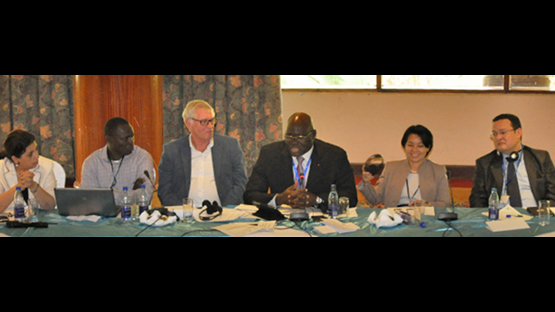The IAEA took the opportunity to reach out to potential partners in nutrition at the recent 6th African Task Force for Nutrition and Food Security Development (ATFFND) meeting in Nairobi, Kenya, from 14 to 15 May. The Task Force, set up by the African Union Commission (AUC), aims to harmonize regional nutrition strategies and support the delivery of high-impact interventions for the management of food security among the most vulnerable population groups.
During the meeting, IAEA staff and other participants discussed activities to address childhood stunting, severe acute malnutrition (SAM), infant feeding and the bioavailability of important nutrients, among other issues. Particular attention was paid to the challenge of stunting, which is primarily a manifestation of malnutrition during foetal development and early childhood. Globally, over 165 million children under the age of five are stunted as a result of malnutrition. This causes irreversible damage to growth and brain development, with long-lasting harmful consequences for cognitive ability, school performance and future earnings. In Africa, where the stunting challenge is more pronounced, 36% of child deaths are attributed to undernutrition.
In tackling child malnutrition, there has been a shift away from efforts to reduce underweight prevalence (inadequate weight for age) to prevention of stunting (inadequate length/height for age). The World Health Assembly has adopted a new target of reducing the number of stunted children under the age of 5 by 40% by 2025. The United Nations Secretary-General has included elimination of stunting as a goal in his Zero Hunger Challenge, launched in June 2012. This emphasis on stunting has led to a review of national programmes and strategies to increase the focus on prevention and integrated programmes.
Fortunately, proven intervention methods, supported by evidence-based information and survey data, can reduce stunting and other forms of undernutrition. These include improving women's nutrition, especially before, during and after pregnancy; early and exclusive breastfeeding; timely, safe, appropriate and high-quality complementary food; and appropriate micronutrient interventions.
The UNICEF Eastern and Southern Africa Regional Office convened a meeting with the IAEA on the margins of the ATFFND meeting to discuss cooperation and partnership opportunities of mutual benefit, particularly in the field of childhood stunting. The IAEA can provide support in the form of national capacity building in the use of the stable isotope technique to collect data on nutritional status, body composition, micronutrient deficiencies and energy expenditure, while partner institutions like UNICEF and non-governmental organizations can build on such efforts through, for example, the provision of advice, complementary food, and support for appropriate micronutrient interventions.
The IAEA, through its technical cooperation programme, has carried out many nutritional projects in the region, including building Member State capacities in the use of the stable isotope technique in Botswana, Ethiopia, Kenya, Namibia, Rwanda, Uganda, Tanzania and Zambia. The IAEA has also become a member of the Scaling Up Nutrition movement, in an effort to scale up its support to Member States health authorities to scale up their nutrition programmes.


